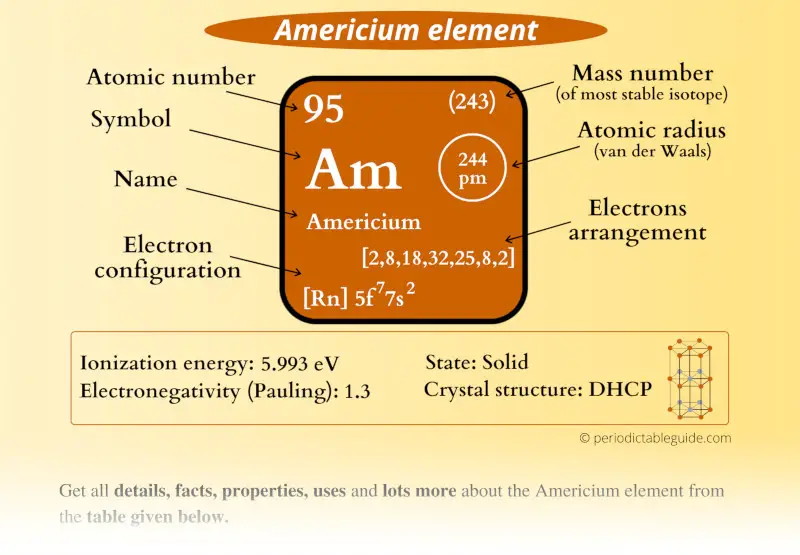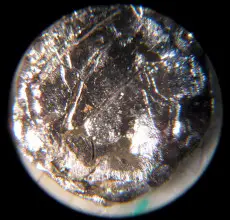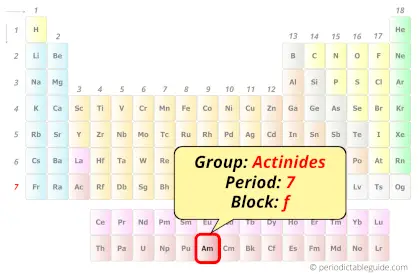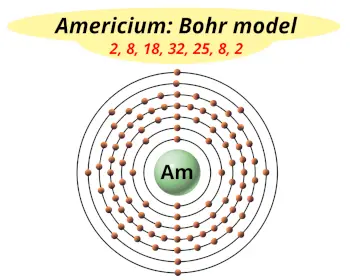
This is a SUPER easy guide on Americium element.
In fact, the table mentioned below is the perfect information box (Which gives you every single detail about the Americium element in Periodic table.)
So if you want to know anything about Americium element, then this guide is for you.
Let’s finish this very quickly.
Americium Element (Am) Information
| Appearance |  Silvery-white metallic appearance |
| State (at STP) | Solid |
| Position in Periodic table |  Group: actinides, Period: 7, Block: f |
| Category |  Inner transition metals |
| Atomic number or Protons | 95 |
| Neutrons | 148 |
| Electrons | 95 |
| Symbol | Am |
| Atomic mass of Americium (most stable isotope) |  243 u |
| Electrons arrangement or Bohr model |  2, 8, 18, 32, 25, 8, 2 |
| Electronic configuration | [Rn] 5f7 7s2 |
| Atomic radius |  244 picometers (van der Waals radius) |
| 1st Ionization energy | 5.993 eV |
| Electronegativity |  1.3 (Pauling scale) |
| Crystal structure |  Double hexagonal close packed |
| Melting point | 1449 K or 1176 °C or 2149 °F |
| Boiling point | 2880 K or 2607 °C or 4725 °F |
| Density | 13.67 g/cm3 |
| Main isotopes | 241Am and 243Am |
| Who discovered Americium and when? | Glenn T. Seaborg, Albert Ghiorso, Leon O. Morgan, Ralph A. James (in 1944) |
| CAS number | 7440-35-9 |
Americium in Periodic table
Americium element is in period 7 and in actinides group of the Periodic table. Americium is the f-block element and it belongs to inner transition metals group.
| H | He | ||||||||||||||||
| Li | Be | B | C | N | O | F | Ne | ||||||||||
| Na | Mg | Al | Si | P | S | Cl | Ar | ||||||||||
| K | Ca | Sc | Ti | V | Cr | Mn | Fe | Co | Ni | Cu | Zn | Ga | Ge | As | Se | Br | Kr |
| Rb | Sr | Y | Zr | Nb | Mo | Tc | Ru | Rh | Pd | Ag | Cd | In | Sn | Sb | Te | I | Xe |
| Cs | Ba | La* | Hf | Ta | W | Re | Os | Ir | Pt | Au | Hg | Tl | Pb | Bi | Po | At | Rn |
| Fr | Ra | Ac** | Rf | Db | Sg | Bh | Hs | Mt | Ds | Rg | Cn | Nh | Fl | Mc | Lv | Ts | Og |
| *Ce | Pr | Nd | Pm | Sm | Eu | Gd | Tb | Dy | Ho | Er | Tm | Yb | Lu | ||||
| **Th | Pa | U | Np | Pu | Am | Cm | Bk | Cf | Es | Fm | Md | No | Lr |
←Move to: Plutonium (Pu) element – Periodic Table
→Move to: Curium (Cm) element – Periodic Table
Why is Americium in Period 7?

Let me ask you a question.
How many shells does americium have?
It’s 7. Right?
You have already seen the bohr model of americium atom in the above table.
From the Bohr model, it can be found that the number of orbits or shells in americium is 7. Hence, as americium has 7 orbits, it lies in period 7 of the Periodic table.
Why is Americium in f-block?

Before knowing this reason, first of all I want to ask you a simple question.
How can you determine the blocks-wise position of elements?
The simple answer: The elements will lie in the s, p, d or f block will completely depend upon the subshell in which the last electron will enter.
For example; the electron configuration of americium is [Rn] 5f7 7s2.
So the last electron of americium enters the f-subshell or f-orbital.
Hence, americium is the f-block element.
5 Interesting facts about Americium
Interesting facts about americium element are mentioned below.
- The name “Americium” was derived from “America”.
- Americium was discovered by Glenn T. Seaborg, Albert Ghiorso, Leon O. Morgan and Ralph A. James in 1944.
- Americium element is generally produced artificially in laboratory, but it also occurs naturally in trace amounts in uranium ores.
- Americium has around 19 isotopes and all those isotopes are radioactive in nature.
- Out of many isotopes of americium, the most stable isotope is 243Am, which has a half life of 7370 years.
Properties of Americium
The physical and chemical properties of americium element are mentioned below.
Physical properties of Americium
Physical properties of americium are mentioned below.
- Americium is a solid metal having a silvery-white metallic appearance.
- The density of americium metal is 13.67 g/cm3, which is near to the density of mercury at room temperature.
- The calculated melting points and boiling points of americium element are 1176 °C and 2607 °C respectively.
- The crystal structure of americium is double hexagonal close packed.
Chemical properties of Americium
Chemical properties of americium are mentioned below.
- Americium is radioactive as well as toxic metal.
- When pure americium metal is kept open in the dry air, it starts tarnishing due to reaction with oxygen.
- There are many oxidation states of americium ranging from +2 to +7, but its most stable oxidation state is +3.
Uses of Americium
The uses of americium are mentioned below.
- Americium dioxide, which contains the isotope 241Am, is used in household smoke detectors.
- 241Am is a good source of gamma rays and hence it is used in some medical applications as well as other industrial applications.
- Americium is used for production of other transuranic elements.
- It is also used as a fuel in spacecraft batteries.
Explore our New Interactive Periodic Table (with Rotating Bohr Models and More)

Details about this Periodic table:
- Access detailed info on all elements: atomic mass, electron configurations, charges, and more.
- View rotating Bohr models for all 118 elements.
- Get a free HD image of the Periodic Table.
Note: For future use, bookmark this Periodic table or visit “PeriodicTableGuide.com”
External resources:
- Americium – Wikipedia. (2023, February 11). Americium – Wikipedia. https://en.wikipedia.org/wiki/Americium
- Americium – Element information, properties and uses | Periodic Table. (n.d.). Americium – Element Information, Properties and Uses | Periodic Table. https://www.rsc.org/periodic-table/element/95/americium
- P. (n.d.). Americium | Am (Element) – PubChem. Americium | Am (Element) – PubChem. https://pubchem.ncbi.nlm.nih.gov/element/Americium
- It’s Elemental – The Element Americium. (n.d.). It’s Elemental – the Element Americium. https://education.jlab.org/itselemental/ele095.html
- Radionuclide Basics: Americium-241 | US EPA. (2015, April 14). US EPA. https://www.epa.gov/radiation/radionuclide-basics-americium-241
- Americium | CCDC. (n.d.). Americium | CCDC. https://www.ccdc.cam.ac.uk/elements/americium/
